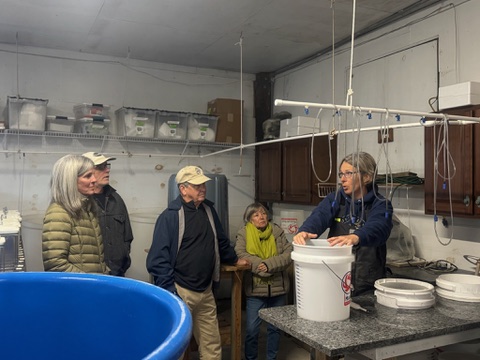
A Day with the Oysters
There’s something special about stepping outside to explore, especially when it’s in a place that feels untouched, where the air smells like saltwater and the land tells its own stories.
 In the Lowcountry, we’re fortunate to have places like this left to explore.
In the Lowcountry, we’re fortunate to have places like this left to explore.
On a chilly morning in February, community members gathered with land trust staff for a field trip at Lady’s Island Oyster Company, nestled in the heart of Seabrook.
That day wasn’t just about oysters—it was about the passion, hard work, and care that goes into each oyster harvested, and how it all connects back to the land and water we protect.
Julie Davis and Frank Roberts, the heart and soul of Lady’s Island Oyster Company, welcomed us with open arms. They shared their process from hatchery to harvest: starting with seed, then larvae, and eventually moving the oysters to cages in the clean, salty waters of the St. Helena Sound.
Their nurseries are surrounded by land protected by the Open Land Trust. Frank and Julie emphasized that clean, high-quality water is crucial for the oysters to thrive.
New insights, a love of oysters and conservation
 One of the participants on the trip summed it up perfectly: “I’ll never eat an oyster the same way again. I have a whole new level of appreciation.” That’s the magic of these field trips—what begins as a fun excursion quickly becomes an eye-opening experience, sparking a deep connection to the land and water we might otherwise overlook.
One of the participants on the trip summed it up perfectly: “I’ll never eat an oyster the same way again. I have a whole new level of appreciation.” That’s the magic of these field trips—what begins as a fun excursion quickly becomes an eye-opening experience, sparking a deep connection to the land and water we might otherwise overlook.
But beyond just being a source of delicious seafood, oyster farming has a bigger role to play.
The oysters Julie and Frank raise aren’t just feeding us — they’re cleaning the water, too. Each oyster filters up to 190 liters (50 gallons) of water every single day, making the surrounding environment cleaner and clearer. These oysters aren’t just a delicious meal; they support an entire ecosystem, providing habitats for fish and other marine life. It’s a quiet yet powerful reminder of how interconnected everything is—from the land we protect to the water that sustains life.
And then there’s the magic of the oyster larvae, which was a new discovery for many of us on the trip.
Before they attach to a rock or another oyster, they spend weeks floating in the water, developing their “foot,” a small appendage that allows them to attach to surfaces and begin their journey of growth. It’s a delicate process that shows just how fragile and vital these creatures — and the waters they live in — really are.
The best part?
Thanks to community support, these field trips are offered for free, giving more people the chance to connect with the land and the people who work to protect it. Every trip brings something new, a fresh perspective on the world around us.
Check out our events page for upcoming trips and volunteer opportunities.
